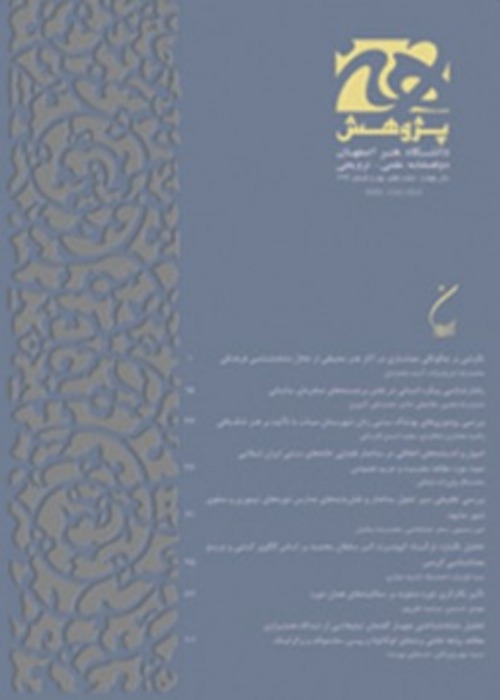An Analysis of Pomegranate Flower Pattern in Iranian Art From Ancient to Saljuk Reign
Author(s):
Abstract:
The origin and the development of the Islamic Pomegranate ornamental pattern (Shah Abbasi Flower) have been the source of curiosity for both native as well as foreign scholars. Among the most significant of the ideas related to the topic, one can refer to Arthur Popes which claims this flower is a continuation of the sided view lotus of the ancient times. But this belief does not explain the degradation of this flower in the first centuries of Islamic art (e. g. Pre-Saljuk) and causes gap filled with ambiguity and then continues its developments and changes after Saljuk period. A like Popes view, another one claims that this flower is the continuation of a patter which in various languages is known as lotus or palm leaf. This idea does not explain the mentioned gap in Popes idea, in one hand, and on the other, by putting various names beside one and other, increases the ambiguity. But how can one explain the origin and the historical development of this pattern without the gap? Is it possible to find this patterns roots in other motifs but Lotus? In order to reach a satisfactory answer, the researcher has used a combination of the historical, analytical and descriptive method. The analysis of the substitute pattern has been done selectively and with the structure of the Palm Leaf as the point of concern. The analysis continues by comparing and contrasting the Lotus and Palm Leaf as two motifs. The paper in had is a qualitative research with a fundamental aim which aims to explain the roots of this pivotal and essential pattern in Iranian art without any ambiguity. Based upon the structural analysis the Palm and Lotus motifs are essentially different and the Islamic Pomegranate only resembles the Palm pattern. The ancient analysis has shown that the Palm pattern, especially in Sasanid period mingled with Pomegranate motif. This combination leaded to the birth of a pattern, which based on the proofs given in the body of the research, existed repeatedly in the first Islamic centuries. Therefore, not only the apparition of the SahAbbasi in Safavid period can be explained based on the degradations of the Palm-Pomegranate without any gap, but also the structural analysis would support that.
Keywords:
Language:
Persian
Published:
Journal of Pazhuhesh-e Honar, Volume:5 Issue: 10, 2016
Page:
11
https://magiran.com/p1515085
دانلود و مطالعه متن این مقاله با یکی از روشهای زیر امکان پذیر است:
اشتراک شخصی
با عضویت و پرداخت آنلاین حق اشتراک یکساله به مبلغ 1,390,000ريال میتوانید 70 عنوان مطلب دانلود کنید!
اشتراک سازمانی
به کتابخانه دانشگاه یا محل کار خود پیشنهاد کنید تا اشتراک سازمانی این پایگاه را برای دسترسی نامحدود همه کاربران به متن مطالب تهیه نمایند!
توجه!
- حق عضویت دریافتی صرف حمایت از نشریات عضو و نگهداری، تکمیل و توسعه مگیران میشود.
- پرداخت حق اشتراک و دانلود مقالات اجازه بازنشر آن در سایر رسانههای چاپی و دیجیتال را به کاربر نمیدهد.
In order to view content subscription is required
Personal subscription
Subscribe magiran.com for 70 € euros via PayPal and download 70 articles during a year.
Organization subscription
Please contact us to subscribe your university or library for unlimited access!


